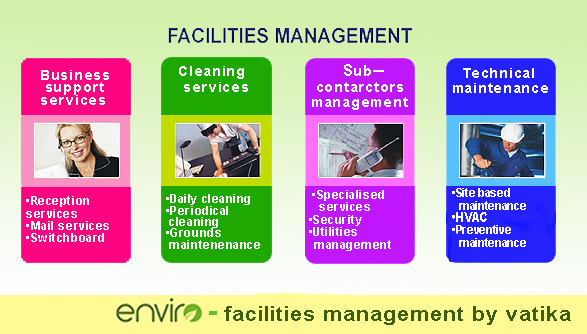Exploring the Benefits of Facility Management in Today's Company Landscape
The Crucial Overview to Facility Management: Strategies for Success
Center management plays an essential role in the total success of an organization, serving as the foundation that sustains performance, performance, and safety and security. The nuances of reliable facility monitoring expand beyond plain logistics and need a comprehensive understanding of both measurable and qualitative metrics.
Understanding Facility Administration
What makes up efficient center monitoring? Reliable center management encompasses the coordination of different organizational features to make sure that constructed settings are secure, efficient, and conducive to performance. Facility Management. It integrates the concepts of company, design, and style management to produce a seamless operational circulation within a company
Trick aspects of center monitoring consist of area planning, upkeep management, and conformity with health and safety and security laws. Room planning focuses on optimizing using physical resources to support business goals, while maintenance monitoring ensures that facilities are maintained in ideal condition, making best use of life expectancy and reducing functional expenses. Compliance with regulatory and lawful criteria is essential, as it safeguards the organization against prospective liabilities and boosts its online reputation.
In addition, efficient facility monitoring relies upon the strategic usage of technology, such as Structure Administration Equipment (BMS) and Computer-Aided Facility Monitoring (CAFM) devices. These modern technologies promote real-time tracking of building systems and streamline upkeep processes. Ultimately, a detailed approach to center management not just promotes functional efficiency however also promotes a favorable atmosphere for employees and visitors alike, driving overall organizational success.
Secret Methods for Optimization
Maximizing center administration needs a calculated technique that straightens functional experiment business purposes. To achieve this, the initial crucial method is the application of integrated technological solutions. Utilizing sophisticated software application systems enables real-time monitoring of center procedures, promoting data-driven decision-making and enhancing total performance.
Second of all, normal evaluations of center efficiency are vital. Performing regular inspections and audits makes it possible for facility supervisors to recognize areas that need renovation, making certain that sources are designated efficiently. This proactive strategy assists in decreasing downtime and boosting solution delivery.
An additional important technique is promoting collaboration throughout divisions. By encouraging open interaction between teams, center supervisors can much better align their strategies with service objectives, causing boosted functional synergy. Furthermore, engaging staff in training programs promotes a society of accountability and improves their ability to add to optimization efforts.
Enhancing Safety And Security Procedures
Strengthening safety and security procedures is important for developing a protected setting within facilities. A detailed safety and security procedure not just safeguards visitors and workers but likewise boosts operational effectiveness. To attain this, center managers need to perform routine risk assessments to ensure and identify prospective threats that ideal steps remain in area.
Educating and education are important components of reliable security protocols - Facility Management. Staff members ought to get continuous training in emergency treatments, devices handling, and individual protective steps. Regular drills, such here as fire emptyings or lockdown treatments, foster experience and readiness among team
Furthermore, clear interaction channels need to be developed to report security concerns immediately. This consists of producing an accessible system for employees to voice possible risks or occurrences without worry of retribution. Leveraging technology can improve safety and security measures; for example, carrying out security systems and accessibility controls helps keep an eye on facility tasks and limit unapproved access.
Lastly, compliance with neighborhood laws and industry standards is non-negotiable. Normal audits and testimonials of safety and security protocols guarantee placement with existing laws and ideal techniques. By prioritizing these techniques, facility managers can grow website a culture of safety and security that shields all stakeholders and inevitably contributes to the organization's success.
Improving Office Environment

Ergonomic considerations are necessary to minimize physical strain and pain. Facility Management. This entails giving flexible furnishings, correct lighting, and adequate space for movement. These changes can bring about lowered absence and raised job satisfaction
Aesthetics play a vital duty in forming the office environment. Using shade psychology, all-natural lighting, and plant can cultivate a stimulating and welcoming environment. Attentively created spaces can increase creativity and boost total well-being.
Moreover, urging worker engagement through comprehensive decision-making processes can enhance the feeling of ownership and belonging. Gathering comments on work environment enhancements and involving staff members in the style procedure can cause a more customized setting that satisfies their needs.
Lastly, advertising well-being campaigns, such as wellness programs and leisure areas, can further add to a supportive office culture. By concentrating on these strategies, center managers can successfully improve the workplace environment, driving both staff member fulfillment and organizational success.
Gauging Success in Facilities
Determining success in center management calls for an extensive approach that reviews both quantitative and qualitative metrics. Quantitative metrics normally include crucial efficiency indicators (KPIs) such as room usage prices, power intake, upkeep costs, and occupancy levels. These metrics offer a clear image of operational effectiveness and economic performance, enabling center managers to determine locations for improvement and criteria against sector standards.
Qualitative metrics, on the other hand, concentrate on customer satisfaction and employee interaction. Studies and responses mechanisms can assess just how well the centers meet the needs of passengers, aiding to assess the general office setting. This aspect is vital, as a completely satisfied workforce is often linked to boosted performance and retention rates.
To properly determine success, center managers should also consider integrating innovation, such as developing administration systems and information analytics devices, to collect and analyze relevant data. Consistently reviewing both sets of metrics permits a more balanced sight of efficiency and educates calculated choices. Eventually, a successful facility management technique depends upon a commitment to constant enhancement, making sure that both operational efficiencies and user satisfaction are prioritized.
Final Thought

Center management plays a critical function in the total success of an organization, offering as the backbone that sustains security, performance, and efficiency.Trick elements of facility monitoring consist of space planning, maintenance administration, and conformity with health and wellness and safety and security regulations.Additionally, efficient center monitoring counts on the tactical usage of innovation, such as Structure Management Solution (BMS) and Computer-Aided Facility Management (CAFM) tools. Inevitably, a comprehensive method to facility administration Facility Management not just advertises operational effectiveness but likewise promotes a positive atmosphere for visitors and workers alike, driving total organizational success.
Eventually, a successful facility management strategy hinges on a dedication to continuous improvement, guaranteeing that both operational efficiencies and user satisfaction are focused on.